Months before our departure, I researched as many boats as possible that spend between three and fifteen days island hopping through the archipelago. The costs were ranging from the high hundreds of Dollars to the high thousands. We both agreed out budget was around $2000 each and we decided that we would book something last minute whilst in Quito to get the most attractive pricing, although at the same time risking not getting everything we hoped for. After multiple trips into the city and chatting with a very helpful couple who had just returned from a fifteen day cruise aboard one of Rolf Wittmers Tip Top fleet of yachts, we had what we hoped would work.
Around ten days before the yacht’s departure date I rushed into Quito and headed straight for the Tip Top travel office in the Mariscal part of the city. The sales rep, Jeniffer, first told me there were available cabins then she threw the $2500 price tag at me, only this would include the $500 return flight giving us a $2000 cruise! This wasn’t quite enough for me as I knew Andrea preferred an upper deck cabin with big windows – if you don’t ask you don’t receive, and with the company waving the $200 upgrade fee we were all set. The regular price for an upper deck cabin on this eight day first-class cruise was $4400, including flights. We had chosen to do the western cruise, primarily as we could visit much of central and south Galápagos from San Cristobal and Santa Cruz, the most densely populated islands, and get to the more inaccessible attractions once on the cruise.
We were so excited to be getting on the cruise and Andrea was having her first proper vacation in a long time. Our first week based on land had flown by and before we knew it we were sitting in the Baltra airport waiting to meet the rest of the guests who were flying in from the mainland, albeit some two hours later than expected! Fortunately day one is low key and by early afternoon Risler, our Naturalist guide, and the fifteen guests had buddied up pretty well and were all set to experience the magic of the Enchanted Islands.

Tip Top III, one of Rolf Wittmers Tip Top Fleet of Yachts

Northwest Galápagos Cruise Map – Route shown in RED
Itinerary
Friday, Day 1
Am: Baltra Island
Pm: Playa Las Bachas (Santa Cruz Island) (WA)
Saturday, Day 2
Am: Sullivan Bay (Santiago Island) (WA / SN)
Pm: Bartolome Island (SN / PR / WA)
Sunday, Day 3 – Genovesa Island
Am: Prince Phillip’s Steps (SN / PR / KY / WA)
Pm: Darwin Bay (SN / PR / KY / WA)
Monday, Day 4 – Santiago Island
Am: James Bay (SN / WA)
Pm: Buccaneer Cove (SN / PR / KY)
Tuesday, Day 5
Am: Punta Vicente Roca (Isabela Island) (PR / SN)
Pm: Punta Espinoza (Fernandina Island) (SN / WA)
Wednesday, Day 6 – Isabela Island
Am: Tagus Cove (PR / SN) – Urbina Bay (WA / SN)
Pm: Elizabeth Bay (PR)
Thursday, Day 7 – Isabela Island
Am: Tintoreras (WA) – Sierra Negra Volcano (WA)
Pm: Tortoise Breeding Center (WA) – Humedales (WA)
Friday, Day 8 – Santa Cruz Island
Am: Charles Darwin Station & Interpretive Center (WA)
SN: Snorkel, PR: Panga Ride, KY: Kayak, WA: Walking
With most of our travel between islands done at night we had full day itineraries consisting of zodiac, or ‘panga’ rides, island walks, and the most eagerly awaited, snorkeling trips – these were always our highlight as the constant possibility of getting up close and personal with hammerhead sharks and huge shawls of rays. Most of our days were broken up into an after breakfast activity, followed by a pre-lunch activity, then a two to three hour siesta spent lazing on the boat, and in the afternoon our final excursion prior to an excellent three course dinner. This never got old and we both agreed that we could have stayed on the boat and completed the next seven day cruise around the central and southern islands.
Santa Cruz
The northern beach of Playa las Bachas being our first port of call after leaving Baltra, and the Darwin Research Center in Puerto Ayora being our exit point on day eight. Santa Cruz is the most populated island of the Galápagos where most people live in Puerto Ayora in the south, accessed by a road cutting right through the middle of the island taking locals and tourists alike to Itabaca channel, either for accessing the airport on Baltra or to join a dive/ cruise boat.
Playa las Bachas is a narrow stretch of fine sand with sally lightfoot crabs alongside brown pelicans lounging on the beach, and greater flamingoes joined by migrant waders preferring to feed in the brackish lagoons.

Playa las Bachas on Santa Cruz Island

Sally Lightfoot crabs

A lone greater flamingo

Migrant waders, including American oystercatchers

Brown pelican relaxing on the warm sand
The Charles Darwin Research station was the second location we saw the endemic giant tortoises of the Galápagos, with around eleven different species from various islands. A few species were already extinct after being decimated, either long ago by pirates, for meat, or by introduced animals such as cows, donkeys, rats, and wild pig. The center has a very successful breeding project underway where the tortoises eventually get reintroduced back to their native environment – a lot of this depends on how well the eradication programs are managing to cull the non-native animals.
Sadly, we were two years late in being able to see the last of one particular subspecies. Lonesome George died of old age at over 100 years after being rescued from Pinta Island, where every other tortoise had perished due to vegetation loss by feral goats. Attempts to mate him with closely related subspecies were all unsuccessful bringing to an end the survival of the Pinta Island tortoise. George served as a potent symbol for conservation efforts in the Galápagos Islands and throughout the world. RIP George!

Plaque commemorating the life of Lonesome George
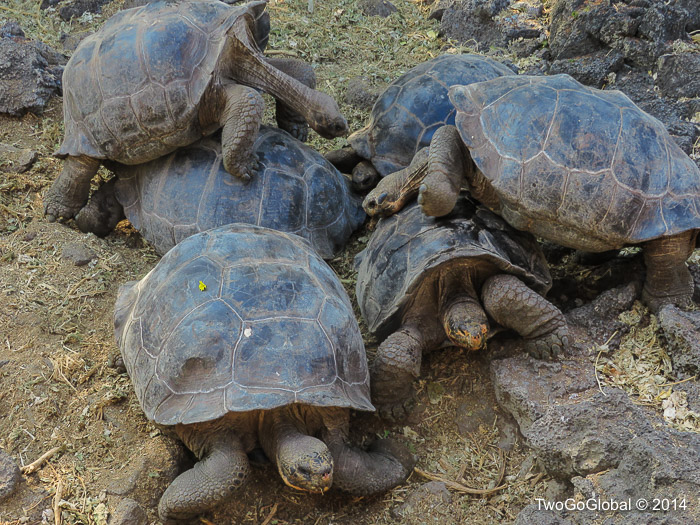
Giant tortoise orgy
Santiago
Our first stop at Sullivan Bay introduced us to some pretty amazing Pahoehoe lava flows, scattered with small craters, lava cactus and the occasional marine iguana. These flows were unlike anything we’d seen before and contrasted so well with the red crabs and iguanas. After a brief walk to take in the scenery we headed to the marine world for our first snorkeling excursion – something which we now looked forward to more than anything, especially after getting within a couple of feet of some menacing looking sharks!

The Pahoehoe lava flows

Unique lava flows of Sullivan Bay

One of many small looking craters

An underwater lava swim-through

Colorful Pacific fish
A few days later, we pulled into James Bay and Buccaneer Cove for more eagerly anticipated snorkeling, walking and a ride along the coastline by zodiac. Here we saw many more marine iguanas congregating in larger groups than we’d seen previously, some swimming, some crawling on others backs, and some squirting excess salt water through their noses – very entertaining. Then there were the obligatory sea lions trying to cool themselves, migratory birds, including America oystercatchers, alongside lava herons chomping on lava lizards, and some pretty cool underwater creatures. White-tip sharks, stingrays, marbled rays and at least a hundred golden cownose rays within touching distance really made our day. Galápagos was impressing us more each day.

Galápagos sea lions cooling off

Marine iguanas cooling off

Sally lightfoot crab on the prowl for food

Diamond stingray

White-tip shark
Bartolome
With its pinnacle icon, awesome scuba diving and golden sandy beaches, this surely was the ideal Galápagos representative. We only had an afternoon to spend here for snorkeling and walking up to the islands highest point for the photo shot, one which I was a little disappointed we hadn’t done earlier in the day due to the late afternoons sun location. Oh well, due to the marine parks extremely strict regulations we knew there was no chance our boat could just switch it’s itinerary so as we could get a favorable shot!
The marine life once again ensured that we didn’t want to leave the water, with all fifteen guests spread out amongst the rocks surrounding the pinnacle in search of sharks, turtles, rays and whatever else the Pacific could amaze us with. This time we also had the privilege of Galápagos penguins to keep us entertained – these are the most northerly penguins and manage to live this far north due to the various currents that keep the water temperature cool and bring in plenty of food.

Bartolome’s famous ‘Pinnacle’

Galápagos penguins

More white-tip sharks

Bartolome’s perfect beach
Genovesa
One of many reasons we chose the northwest itinerary was to visit Genovesa, renowned for it’s bird colonies. Andrea and I both have to say it was snorkeling along a deep wall and seeing hammerhead after hammerhead that blew us away, although the birdlife came a very close second!
After a brief panga ride along a rock face where Galápagos fur seals lazed about we landed at Prince Philip’s Steps, our first port of call and the place where we ditched all of our previous photos of the occasional distant great frigate bird and nazca booby. This was their territory, the island where male great frigate birds put on an impressive display with hugely inflated and bright red chests to attract a mate, and red-footed boobies made chattering sounds whilst waving their beaks in the air. This was like nothing we had see so far, with photo opportunities getting better and better, and the birds seeming to get tamer and tamer!
Then it was time for water activities, where within minutes of rolling off the side of the zodiac we witnessed passing hammerhead sharks – how we both would have loved to be diving at this location. Time after time our guide would be yelling us over to see more sharks and rays than we could have imagined – the entire group was on a high and none of us wanted to get back in the boat.

Red-footed booby

Nazca booby

Male great frigate birds with deflated egos

Male great frigate birds

Red-footed booby chick
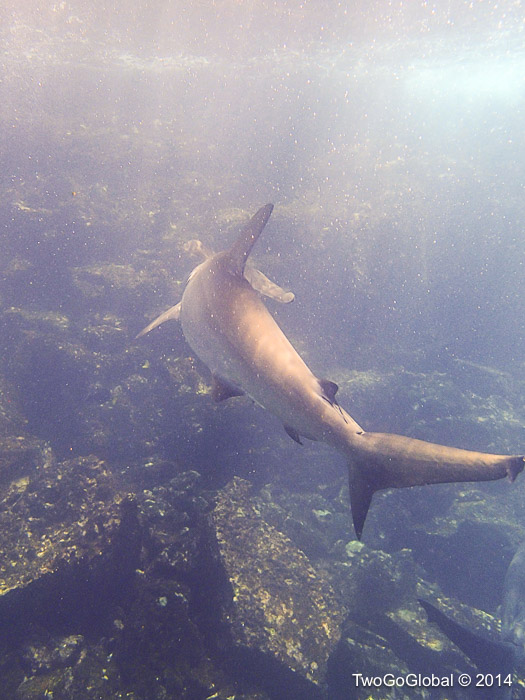
An impressive hammerhead shark
The afternoon went a similar way to the morning with a visit to Darwin Bay for more frigates and boobies, many with chicks almost ready to take their first flights. Snorkeling, only this time minus the sharks was not quite the same, although a solo spotted eagle ray effortlessly gliding by was always going to make it worthwhile.
We found that life on and around this more isolated island was that little bit richer than previous islands, probably due to the less frequent visits by humans, and if it was possible making the birds that little less fearful of us!

Great frigate bird showing off to a female overhead

On the beach at Darwin Bay

Spotted eagle ray

Galápagos sunset
Isabela
The largest and one of the youngest islands in the archipelago, Isabela sits right over a volcanic hotspot with five active volcanoes spread over its 4.640 square kilometers. Due to its size our cruise spent almost three days along its western and southern shores where we had land excursions, snorkeling, and the chance to chill out in the islands populated town of Puerto Villamil. En route to our first stop at Punta Vicente Roca, we cruised by Volcan Wolf and we felt the “bump” of the equator as we passed over zero degrees latitude!
On one of the panga rides as we slowly maneuvered along the shoreline we observed curious Galápagos penguins and flightless cormorants checking us out, marine iguanas trying to make the most of early morning rays, and even a small pod of dolphins accompanied us for a while. Under the water was Pacific green sea turtle territory – we saw so many that they didn’t even capture our attention after a while. We were more blown away with flightless cormorants coming right up to our masks and penguins shooting by us in pursuit of breakfast. It didn’t matter how long we spent here, we still couldn’t get used to how unafraid the animals were, both in water and on land.

Punta Vicente Roca at Isabels island

Crossing the equator in the north of Isabela

Marine iguanas waiting for the sun
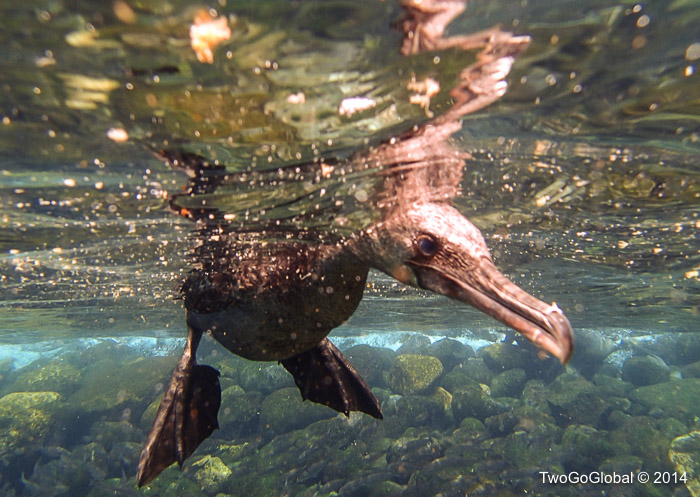
An inquisitive flightless cormorant

Galápagos penguin in hot pursuit
Over the next couple of days as we headed south along Isabela, with stops at Tagus Cove, Urbina Bay and Elizabeth Bay, the guided walks took us away from the shoreline to see our first giant tortoises, synonymous with the Galápagos. It was like something from Jurassic Park with oversized tortoises and huge land iguanas strolling along lava footpaths. Even though the lava landscape was very similar between islands the animals were very endemic and seemed so isolated to their own areas within the islands. Many years ago the tortoise population in the Galápagos was huge, especially on Isabela, but due to man, introduced species and volcanic eruptions their population has been decimated – it would have been such an experience to see these prehistoric creatures in the thousands, where nowadays you see them occasionally.

A small giant tortoise

Land iguana
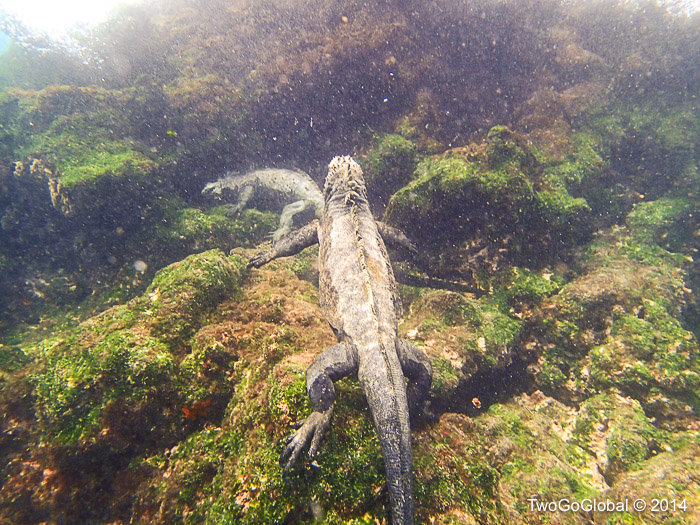
Marine iguanas feeding on algae
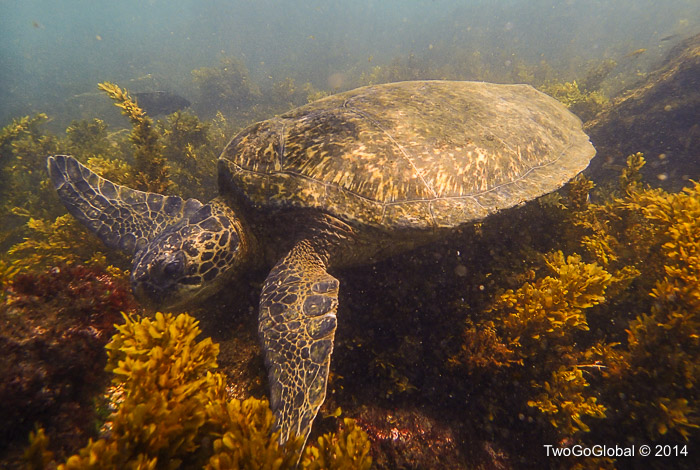
One of many Pacific green sea turtles
Before departing on an overnight sailing to our final Isabela destination we took a panga into the shallow mangroves, home and security for baby sharks, rays and turtles – the water in these areas was crystal clear making it easy to spot anything that swam by us as we hung over the side of the panga. These waters would have made the best snorkeling but unfortunately the park services have many restrictions on when and where tours/ tourists can go. Fortunately these rules keep this amazing archipelago as pristine as possible.
Our arrival in Puerto Villamil signaled the end of our Isabela landings, and with what seemed like lightning visits the end of this island came far too hastily! As well as sandy beaches, volcanoes, lava fields, and mangroves we now had civilization – I think we both preferred the peacefulness away from the islands towns. The town did provide us with the necessary transportation up to Volcan Sierra Negra, and a short hike later the rim of the huge caldera welcomed us – pity about the shadows and clouds but thankfully no rain.

Mangroves around Elizabeth Bay

Pacific green sea turtle safe in the shallow mangroves

Islote Tintoreras in the south of Isabela

Perfect spot to sun yourself

Galápagos sea lions will sleep anywhere

Puerto Villamil

A very active Volcan Sierra Negra, the third largest caldera in the world
Fernandina
This most westerly island is an active volcano, erupting since 2009 – like all others in the archipelago it was formed by the Galápagos volcanic hotspot, and due to its isolated location making it one of the most pristine of all the islands with no introduced species. The half day excursion took us to Punta Espinoza, where we encountered the largest groups of marine iguanas so far, lying all over each other and completely oblivious to the strange looking two legged creatures walking amongst them. As well as iguanas, scattered throughout the relatively fresh lava were flightless cormorants, the occasional penguin, and sea lions, all seemingly totally relaxed at our presence.

Marine iguana enjoying the company of sally lightfoot crabs

Lava cactus

Flightless cormorant having projectile pee

A mean looking dinosaur

Galápagos sea lion family
Finally, check out our Galapagos Video compilation…
March 21st – March 28th 2014

